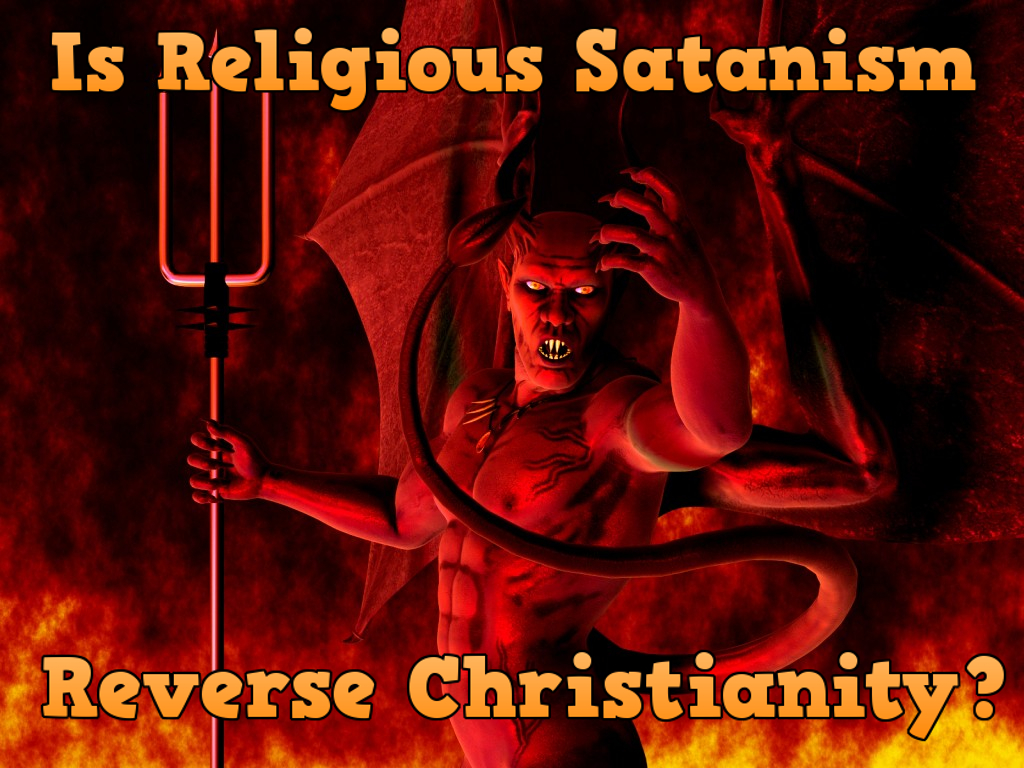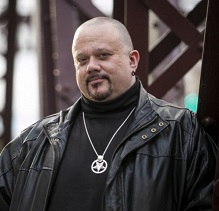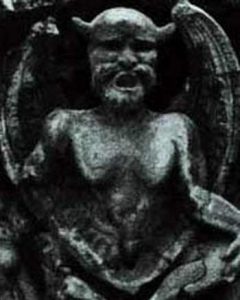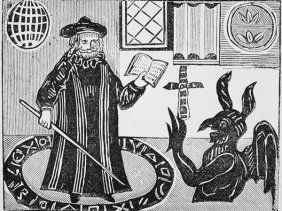Is Theistic and Spiritual Satanism Just Reverse Christianity?
Theistic and Spiritual Satanism, is it just reverse Christianity? It’s an important question to confront, and one that has been asked many times about Theistic and Spiritual Satanists.

 Is Religious Satanism Reverse Christianity?
Is Religious Satanism Reverse Christianity?
Theistic and Spiritual Satanism, is it just reverse Christianity? It’s an important question to confront, and one that has been asked many times about Theistic and Spiritual Satanists.
Are we just reverse Christians? Or, is there something more behind Satanic spirituality that defines it as something unique?
Let’s ask the real questions!
This is a controversial topic, but what would Satanism be without some controversy? To explore this idea of religious Satanists as reverse Christians, we should first go to the source of where this idea comes from.
In numerous interviews, atheistic Satanists in attempt to distance themselves from non-church members, make the claim that anyone who is a spiritual or religious Satanist is a ‘devil worshiper’ who simply inverts the Christian cosmology.
In general, atheistic Satanists believe that spiritual or religious Satanists are practicing reverse Christianity, are on the fringe of Satanism, and don’t represent Satanism in any way.
However they want to define it, spiritual and religious Satanism has its own unique culture that we share, which differs from Christianity in many obvious ways.
What ‘they’ Believe!
A recent October 2017 Face to Faith radio interview at the Chicago Sun-Times, with a Church of Satan member shows the general attitude of atheistic Satanists today on the idea of Satan worship. Their guest was G. Edwin Taylor, a warlock and member of the Church of Satan. In his interview he was asked if devil worshipers were real. Edwin makes the point that there are religious Satanists outside of the Church of Satan, which he labels as ‘devil worshipers’. A quote from his interview illustrates this idea:

“I’m sure that there is (devil worshipers). . . but they’re not Satanists. They’re still in the part of that Christian religion. Instead of believing in the good guy, they’re believing in the bad guy, and they’re thinking, ‘Ooh, there’s a devil with horns and a barbed tail sitting on a throne of bones,’ you know, fires surrounding him, when it’s fiction.”1
Mr Taylor speaks about his version of Satanism in an easy to listen to manner so this interview is definitely worth a listen whether you are religious or not.
However, in many media interviews with LaVeyan Satanists the same type question is asked about Satanists believing in a literal Satan, often with a reply that religious Satanists are ‘kooks’, or ‘nuts’. That religious Satanists are nothing more than ‘reverse Christians’.
They can believe however they want. Still, it’s interesting to note how the non-spiritual side of Satanism wants to define what religious Satanism is, and what it is not.
What Mr. Taylor and others like him might not know, or even care about, is the other side of the story.
Understanding the History of Satanism and Satan Worship
To understand the evolution of Satanism from a religion into a philosophy this you have to know a bit of Satanic history. The Church of Satan, founded in 1966, experienced a split between those who had a more spiritual view, and others who wanted their version of Satanism to remain symbolic. This split created the temple of Set, a separate religious sect of Satanism, in the late 1970’s.
Satanism hadn’t even been around for more than a decade before some had decided that they wanted something more than just basic Satanic symbolism and philosophy.
However, it wasn’t always like this. At one time it seemed that Satanism had been established as a religion before it became a philosophy. Early interviews with LaVey illustrate this idea.
Anton LaVey on ‘Satan as a God’

In one of the earliest television interviews on Satanism, in 1970, LaVey sat down with Joe Pyne to discuss the Church of Satan. In this interview, LaVey’s church was in it’s early years and it seemed that LaVey still had a mostly religious view of Satan.
Pyne asked, “You call yourself a Satanic priest, that the opposite of god?” LaVey answered in a serious and thoughtful way, “No, because Satan is a god too”.2
The audience was silent. Such words had never been spoken about Satan in public!
Back then, it seemed that the Church of Satan treated Satanism as a religion. But over time, the story changed in accordance with public attitudes both real and imagined, towards Satanism.
Throughout the 70’s ideas on what Satan and Satanism was according to LaVey had evolved away from religious ideas. In a book interview with John Goodwin, LaVey stated that Satan was a god-like force, but only in a symbolic way:
“How do we visualize Satan? Purely symbolically, as the all-pervasive force. The only true God, in fact.”3 By then the shift towards Satanism only as a symbolic philosophy had begun. I discuss some of these ideas further on the Is Satanism a Religion or Philosophy page.
By 1975, the divide between philosophy and religion was clear. Satan within the Church of Satan had become a metaphor and was no longer associated with anything spiritual. In an interview with Occult San Fransisco, LaVey stated that “Satanism is a philosophy that has been formulated and organized into a productive social force”.4 The script had changed.
Christianity as a Reaction to Satanism
During the rise of the Church of Satan, a social panic spread across America, blaming innocent people for Satanic ritual murders. It was the book, Michelle Remembers, a vivid account of recovered memory syndrome that ignited the firestorm making the claim that there were underground networks of thousands of Satanists.
Years later, it was proven that recovered memory was an unreliable source of witness testimony and eventually was banned from being used as evidence in criminal cases. No evidence was ever found in the thousands of cases that made it to court, but people didn’t realize this until some time later after the cash cow of Christian books and seminars and television personalities had dried up.
During the height of the Satanic panic from the 1980’s to the early 90’s the Church of Satan came forward to defend themselves against accusations of ritual abuse, and to cut ties from the types of people that Christians had blamed for those crimes. In nationally televised interviews, spokespeople from the Church of Satan claimed that their brand of Satanism was non-religious. They made the claim that it was an atheist philosophy, dividing themselves from the Christian ideas about Satanism even further.
Satanism, back in the 90s!
The idea that there were real Satanists in the world was still pretty shocking and controversial to people back in the 90’s. Anton LaVey’s daughter, Zeena LaVey, who was high priestess of the Church of Satan at the time sat down with news reporter Tony Valdez to discuss Satanism in 1990.

In a direct statement, the interview began with the question of devil worship, “how can anyone worship the devil?”, he asked. Zeena replied,
“Yes, that is a common misconception and I have to state it, we really don’t worship the devil, we don’t believe in any outside deities, whether they be god or Satan.”5
Two years later in 1992, with the publication of Anton LaVey’s last book Secret Life of a Satanist, High Priestess Karla LaVey, and Magistra Peggy Nadramia spoke with Joan Rivers on Satanism.
When asked about Satanists beliefs, Nadramia spoke about Satanists abandoning Christianity and leaving Christian ideas behind. According to her
“A Satanist is someone who has turned their entire back on the Judaeo-Christian mythology, the Judaeo-Christian morality; they’ve turned their back on the whole idea of having a god to adore and an afterlife to look forward to.”6
Of course, Ms. Nadramia was speaking only of the Church of Satan’s brand of Satanism. By the time the 90s came around, the Church of Satan wasn’t the only game in town, but they were the most visible in the public eye. Atheistic Satanism took the front stage. While there were theistic and religious groups, they were, over time, diminished and demonized by Satanism’s own, through the media and eventually online.
Satanism is Diverse
But what do spiritual and theistic Satanists feel about Satan? For a look at this we turn to some authoritative voices in the religious Satanist scene.
Satanism has always been decentralized, meaning that there is no one singular philosophy, belief or idea that unites us all.7
As such, Christianity is not always the main focus for theistic Satanists. Some believe in a spiritual warfare scenario with a literal god vs Satan cosmology, and others incorporate various mythologies from all around the world into their belief systems. Also, some religious Satanists focus on a gnostic (non-Christian) worldview of Satan. To simplify it and say that it is only black and white, and reverse Christianity, is to miss the point that Satanism is diversified and does not have a central ideology.
Satanists may even include pagan gods into their spirituality and worship. On the question of religious Satanism aligning with paganism, it is pointed out at the Pantheo pagan blog that Satanists use a variety of means to express themselves.“As a result many Theistic Satanists are also polytheists, and might worship deities like Pan and Kali as personifications or versions of Satan.”8
Satanism, like paganism, is one of the few religions in the world that offers such potential for diversity.
Satanist Jashan A’al correctly points out that Satanism is diverse and there is variety to be found. In his Foundations of Satanism article he writes, “Satanic denominations are, in all likelihood, more dissimilar from each other than the majority of Christian denominations … Some believe in no gods; some believe in abstract forces; some believe in an ancient, pre-Christian being; and some believe in the Biblical Satan.”9
With such a variety of beliefs and ideas that help to fuel religious Satanism, the idea that it is ‘simply reverse Christianity’ seems like a small portion of what religious Satanists actually focus on.
What about those who do worship the Christian Satan?
I discussed similar ideas on my Spiritual Satanist blog back in 2009, in a post about Satan: To Worship or Not to Worship where I describe various types of Satanic worship. Subservient worship of Satan is most often related to inverse Christianity. This type of worship is most often related to ‘Traditional Satanism’, reverse Christianity, and Diabolism.
It is the outright, blatant worship of the Christian version of Satan. Some feel as if they are under his control or that they are to do what they feel Satan makes  them do. To do Satan’s bidding, as it’s known.
them do. To do Satan’s bidding, as it’s known.
But, as I point out, not all Satanists who worship Satan feel the same way, nor do they all recognize Satan as a christian invention.
Those who do worship the Christian Satan and practice reverse Christianity are often disregarded as criminals by other spiritual and theistic Satanists, themselves.
From the Satanic Views Blog, on the subject of the Order of the Nine Angles and other criminal individuals,
“These are individuals who have taken literally the Christian definitions of Satan and Satanism, and inflict harm to property and life for the purposes of excitement or as a trade to Satan for an anticipated reward such as money, fame and power. These are the individuals, often mentally ill or intellectually impaired, who define themselves as Satanists and appear in the media associated with various crimes such as ritual murder.”10
in general, both atheistic and theistic Satanists condemn these types of criminal acts. In reality most Satanists are law abiding people who try to be productive members of society, just like everyone else.
It is pointed out by the Satanic community at large, that ‘reverse Christianity’, is often a label that is appropriate for those who commit crime in the name of Satan. This is easy to understand if you take the ideas of Christianity, and reverse them, to portray Satanists as criminals, much like what happened during the Satanic panic. The people that follow the ideas of what happened in the Satanic panic, are following a Christian idea of what Satanism is.
During that time, people actually believed that Satanists were murdering babies and kidnapping children, which is what one would expect a Christian to believe during that era of misinformation and fake news. In today’s times there is a small (but frightening) fraction of Satanists who do commit crime in the name of Satan. But you will find that religious extremism is found in almost ever major religion, including Christianity.
What about the afterlife and the “Devil with horns”, and Hell?
What about the eternal place of torture, known as hell? How many spiritual or religious Satanists believe that there is a hell?
I’m a big fan of actual data, I like to see the numbers. It gives us an outside view of the issues. In a survey report, titled ‘The Invention of Satanism’ from 2015 analyzed what Satanists believe about the afterlife. A wide variety of Satanists were surveyed, ranging from atheistic to religious.
While the majority claimed that there was no afterlife, this is easily explained by the fact that the majority of Satanists who responded were atheistic Satanists, who, along with the Satanic Bible as a doctrine, promotes the belief that there is no afterlife.11
Other religious or spiritual Satanists believed (in order of preference) that there was ‘some conscious survival of the soul or self in some other realm’, The option for ‘other’ existed giving a vague answer to the afterlife, for some, there was a belief in ‘reincarnation’, and finally that the ‘soul merges into the cosmos’.
In all, it was the belief that there is a conscious survival in the afterlife which was the most popular choice, but the survey did not state whether this realm was specifically the Christianized version of hell. Christianity does not offer the belief in a ‘conscious survival’ after death. So for those who didn’t identify with atheistic Satanism, the belief in the Christian version of hell seemed marginal, at best.
Just for fun, Actual Christian Satanism! And it’s not Reverse Christianity!

Christian Satanism does exist but it seems to be a very specialized area of Satanism. Two examples that I found were the Christian Satanic Bible, and the Final Bible of Christian Satanism.
The Christian Satanic bible, created by Adam Capps, claims to represent ‘Christian Satanism’, that it is a theological work of Satanism representing the (christian) Satanic religion.12
The second book, The Final Bible of Christian Satanism By Lucifer Jeremy White, makes the claim that the Christian god created two sides to Christianity and that Satanists should come forward and claim it as theirs. Calling himself a ‘grey sheep’, he offers guidance based on what he believes the Satanic Bible nor the Christian bible could offer.13
These were the only two specific mentions of Christian Satanism that i could find, but as you can see, it is not something that is popular among Satanists, in general. these versions of Satanism also do not seem to be reverse Christianity, either.
The problem, however, is that Satanic atheists want to put us all in the same box just because some Satanists have a spiritual or religious view, regardless of what that view might be.
In conclusion..
Christianity does not decide what Satanism is any more than the Church of Satan can decide what all Satanists should believe. Satanists don’t have a singular voice or opinion on what all of Satanism represents. We are not unified.
So, to sum it up, for atheistic Satanists to claim that religious Satanists are nothing more than reverse Christians, ‘devil worshipers’ who believe in a ‘pitchfork toting demon from hell’, they clearly miss the obvious point that Satanism is diverse. Those who believe the idea that religious Satanism is reverse Christianity are behind the times. They are still stuck in 90’s Satanic Panic mode. They haven’t done their research. They tell a half-truth. It is an attempt by atheists to minimize competition and alienate anyone who does not subscribe to their singular doctrine.
Atheistic Satanism may be in the majority, they may be the public face of Satanism, but they do not speak for all of us. Religious and spiritual Satanism is on the rise and it has been for quite some time, and it is a diverse arena of beliefs that make it unique. Spiritual Satanists express themselves in a personal way, through building on their own beliefs to create their own unique way of life.
Satanism is a free expression of personal will that can not, and should not, and will not be defined by the voice of one organization.
References:
- Chicago Satanist: There is No Devil, Humans ‘Are our Own God’ Face To Faith Radio Show (accessed 11/11/17)
- 1970 Interview with LaVey on the Joe Pyne show: beginning at 1:57 – 2:06 https://www.youtube.com/watch?v=Kqb54soKU8M&t=20s (accessed 11/11/17)
- Occult America, John Goodwin, 1972. Excerpt from the Church of Satan website (accessed 11/11/17)
- Anton LaVey – Occult San Francisco Interview, 1975: beginning at 0:52 https://www.youtube.com/watch?v=jt0RVBRyJWU (accessed 11/11/17)
- Zeena LaVey Interview on KJTV with Tony Valdez, 1990, beginning at 2:33 https://www.youtube.com/watch?v=IaWbVYBZu7s (accessed 11/11/17)
- Karla LaVey, Peggy Nadramia, The Joan Rivers Show, 1992, beginning at 1:36 https://www.youtube.com/watch?v=RB_v_669ctc also: (Secret Life of a Satanist at Amazon) (accessed 11/11/17)
- Lewis, James R.; Jesper Aagaard Petersen (2004). Controversial New Religions. Oxford University Press. p. 429. (accessed 11/11/17)
- Are Satanists Pagan? Jason Mankey, Pantheos Blog, 2012 (accessed 11/11/17)
- Foundations of Satanism, Jashan A’al, November 2000 (accessed 11/11/17)
- Is ONA and Reverse Christianity Satanism?, Satanic Views Blog, August 2015 (accessed 11/11/17)
- The Invention of Satanism Asbjorn Dyrendal, James R. Lewis, and Jesper Aa. Petersen (accessed 11/11/17)
- Christian Satanic Bible (at Amazon), Adam Capps (accessed 11/11/17)
- The Final Bible of Christian Satanism, (at Amazon), Lucifer Jeremy White (accessed 11/11/17)
Return to the Satanism Essays Page
VISIT THE SPIRITUAL SATANIST SITEMAP
Make sure to share this page if you liked it:














